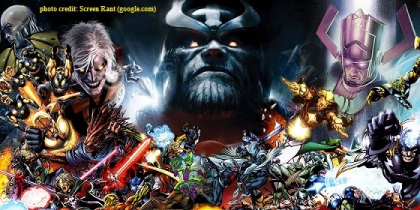Reconfiguring Mythology
 (I wrote this essay a few years ago after watching the first ‘Avengers’ movie and before the showing of “Prometheus.” Screenwriters and movie producers have been mining the pages of Mythology and Legend for their movie projects. Both Marvel and DC (and their partners) keep coming out with movies where their resident superheroes either make friends or clash with mythological and legendary characters and creatures. Watch “Wonder Woman” and you’ll see how elements of “Greek Mythology” were fused into the movie. Go watch the latest “Transformers” movie next and find out whether Merlin, King Arthur and the knights of the round table sided with the Autobots or with the Decepticons.)
(I wrote this essay a few years ago after watching the first ‘Avengers’ movie and before the showing of “Prometheus.” Screenwriters and movie producers have been mining the pages of Mythology and Legend for their movie projects. Both Marvel and DC (and their partners) keep coming out with movies where their resident superheroes either make friends or clash with mythological and legendary characters and creatures. Watch “Wonder Woman” and you’ll see how elements of “Greek Mythology” were fused into the movie. Go watch the latest “Transformers” movie next and find out whether Merlin, King Arthur and the knights of the round table sided with the Autobots or with the Decepticons.)
Recent movies I watched (“Clash of the Titans”, “Thor” and the “Avengers”) have brought me endless amazement. Amazed because my favorite characters in classic literature come alive in fresh story lines stuffed with visual and sound effects that are breathtakingly outstanding and astounding.
But more than the amazement, the said movies also inspired me to revisit the subject in Literature that I have always considered most interesting – Mythology.
Of course we know that the Titans are entities from Greek Mythology. Seemingly, movie producers are casting their lots on the Titans nowadays. “Prometheus” (which is the title of the movie that soon I will be watching) himself is another Titan. What remains to be seen is whether or not in the movie Prometheus plays out his role of stealing the heavenly fire for the benefit of humanity.
Conversely, Thor and Loki, who appeared in both “Thor” and “The Avengers” are both characters in Norse Mythology.
Generally, script writers and movie producers are seemingly mining the pages of Mythology for their movie projects.
Movies similar to the aforementioned clearly show how enormous advancement in technology benefited Mythology. There’s nothing now that creative writers can’t describe in their narratives that 3D and 4D computer graphics can’t project unto the silver screen.
The unbelievable visual effects made possible through Computer Graphics Imagery (CGI) thrill movie goers and startle them no end. This is one of the best ways to present Mythology. All those imaginary creatures, out-of-this world settings and incredible circumstances would no longer be left for the audience to imagine but for their eyes to feast upon.
What would be the educational implications of this modern rendition of Mythology?
Teaching the said subject has become easier and learning on the part of the students become more fun. For teachers, the movie versions (or even just a few clips) of stories from the pages of Mythology may serve as their audio-visual materials. Discussions during classes will be greatly augmented by the visuals students see in the movies. Lest we forget that the current generation of learners are visual. The better they learn when presented with images, pictures and colors. With the right movies, they learn while having fun.
It could be true that the movie versions of Mythology may make students disinterested with reading but one thing we should bear in mind is that the learning landscape has changed. Through viewing learning could be achieved as well. Viewing, just like reading , has lately been classified as a macro skill in language also.
These reminds me of the suggestion made by one of my students in Creative Writing before. She said that to make sure that the students would read the original story and not just rely on the movie version one activity that could be designed is ask them to find the portions of the original story modified in the movie version.
Could it be that learning Mythology becomes more effective through “viewing” than through “reading?” This is not saying that today’s generation of learners should no longer be encouraged to read. For each area of knowledge there is a corresponding macro skill most applicable. Methinks that for Mythology it is “viewing.”
However, teachers need to pay attention to the discrepancies between the original story and the movie versions. They have to warn the students about such.
For instance, in the movie “Troy”, the Trojan war took place in less than a month. In the original story (Homer’s Iliad), the war ended after ten years. The movie also shows Paris killing Menelaus which is not the case in the original story. The foregoing are but a few of the many discrepancies.
The teachers have to be on the lookout for possible changes to the original story. They themselves need to recognize the changes so the students get to be informed.
Perhaps the movie producers needed to tinker with the original storylines of the “classics” to make the movie versions more cinematic. Understandably, not all the details in the original stories can be included but at least the brains behind the movie production be sensible enough not to change significant details in the story.
Another thing that teachers should be ready for are questions like “Are the Hulk and the Iron Man mythological characters?”
“Myth” is traditionally defined as a story about gods, heroes or imaginary animals which has been handed down from one generation to another from primitive times and is usually of a religious nature. Additionally the purpose of myths is to explain some belief or natural phenomenon.
Should the foregoing definition be considered, the Hulk and the Iron Man are not mythological characters. In the movie “The Avengers” only Thor and Loki fall in that category.
Experts differ in opinion as to whether or not the companions of Thor and Loki in “The Avengers” be classified as mythological characters. Others contend that they are simply fictional characters or superheroes that appear in comic books. Their stories do not bear the prerequisites for a myth.
Some are saying that stories in the comic books are part of “modern mythology.” It is not. In a strict sense the term “modern mythology” is delivering classic mythology using as medium the modern technology available nowadays.
What could really be considered as modern version of mythology are the “urban legends.” “Batman,” also a famous character from the comic books is said to be part of urban legend. Thus, if the comic book character Batman, technically, is a Mythological character, urban legends being a modern version of Mythology, what about the rest of the comic book characters?
Then, the discussion goes in full circle again.
But who knows, with characters from Mythology and comic books finally brought together either as friends cooperating or enemies locking horns in the movie “The Avengers” a redefinition of the term MYTH may follow.

Leave a comment
Comments 0